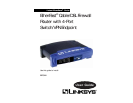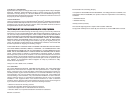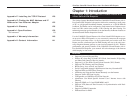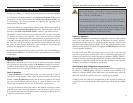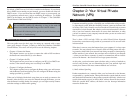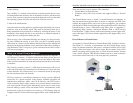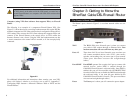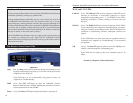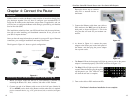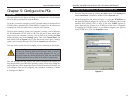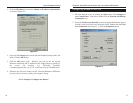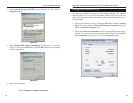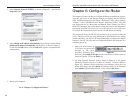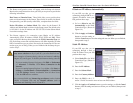
EtherFast
®
Cable/DSL Firewall Router with 4-Port Switch/VPN Endpoint
9
Chapter 3: Getting to Know the
EtherFast Cable/DSL Firewall Router
The Router’s ports, shown in Figure 3-1, are where network cables are con-
nected
WAN The WAN (Wide Area Network) port is where you connect
your cable or DSL modem through an Ethernet cable. Your
modem connection will not work from any other port.
Ports 1-3 These three LAN (Local Area Network) ports are where you
will connect networked devices, such as PCs, print servers,
switches, and anything else you want to put on your network.
(These ports auto-detect crossover and straight-through
cables.)
Port 4/DMZ Port 4/DMZ operates like a regular LAN port to connect with
network devices, unless DMZ is enabled through the
Cable/DSL Firewall Router’s web-based utility. Once DMZ is
enabled, this port will be accessible with NO PROTECTION
from the firewall. Be sure to disable the DMZ function through
the web-based utility if you want this port shielded by the
Cable/DSL Firewall Router’s firewall. (This port auto-detects
crossover and straight-through cables.)
Power The Power port is where you will connect the power adapter.
The Router’s Back Panel
Figure 3-1
Instant Broadband
®
Series
8
Computer (using VPN client software that supports IPSec) to Firewall
Router
The following is an example of a computer-to-Firewall Router VPN. (See
Figure 2-2.) In her hotel room, a traveling businesswoman dials up her ISP. Her
notebook computer has VPN client software that is configured with her office's
VPN settings. She accesses the VPN client software that supports IPSec and
connects to the Firewall Router at the central office. As VPNs utilize the
Internet, distance is not a factor. Using the VPN, the businesswoman now has
a secure connection to the central office's network, as if she were physically
connected.
For additional information and instructions about creating your own VPN,
please visit Linksys’s website at www.linksys.com or refer to “Appendix C:
Configuring IPSec between a Microsoft Windows 2000 or XP PC and the
Firewall Router.”
Important: You must have at least one Firewall Router on one end of
the VPN tunnel. At the other end of the VPN tunnel, you must have a
second Firewall Router or a computer with VPN client software that
supports IPSec.
Figure 2-2



